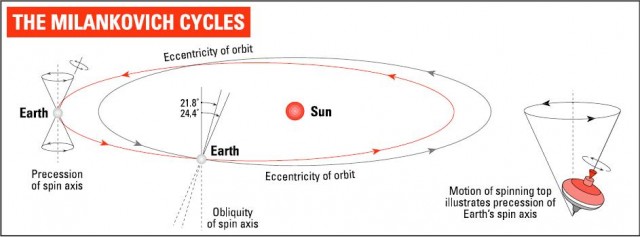Longer-term climatic cycles
In addition to the annual cycle of the seasons, there are longer-term cycles at play which affect the amount of energy the Earth receives from the Sun, causing significant variations in the Earths climate.
First, there have now been almost 400 years of routine observations of the Sun which show that sunspots appear on its surface with a 22-year periodicity. Sunspots are areas of the sun marked by intense magnetic activity and a slightly lower temperature than surrounding regions. They look dark only because we see them against the Sun's surface. In fact they are almost as bright (and hot) as the rest of the Sun. If one were magically transplanted to the night sky it would be dazzlingly bright. They are the signs that the Sun is especially active and is pushing out more energy than usual into space. As we shall see in Chapter 8, there are those who claim that these changes in the Suns power output are the secret behind global warming and that it has nothing to do with human activity. (To show my own bias, I also note that these tend to be the same people who claim that no warming is going on anyway, but we'll come to that later.)
On a longer timescale are the “Milankovich cycles”, named after Serbian astronomer Milutin Milankovich. First, the 23° tilt of the Earth's orbit to the Equator is not fixed, but varies between about 22° and 25° over a period of around 41,000 years. When the tilt is greater, the seasons get more severe, with hotter summers and colder winters. The latter is likely to be the more important of the two. It means that more snow will tall and stick, and so increases the chances of an ice age taking hold.

Secondly, there is the precession of the equinoxes, discovered by the astronomer Hipparchus in the second century BC. Imagine the Earth spinning like a top. Then imagine the way a top which is slowing down tilts over, so that the direction of its spin keeps moving around in a circle. That is precession. It takes about 22,000 years for a full loop to be completed.
This precession has a number of effects. One is that maps of the sky get out of date, so you need to specify the year in which they were accurate – for example, the Pole Star that helps people in the northern hemisphere to navigate has not always been near the North Pole. More importantly for our purposes, it means that 11,000 years ago the Earth was at its closest to the Sun in July instead of January, northern hemisphere summer rather than southern. Again, this might encourage ice ages by allowing more snow and ice to form in the northern hemisphere, where most of the big land masses are (glance at a map or globe to confirm this).
Finally in this cosmic dance, even the Earths orbit is not quite the constant you might think. Its eccentricity varies over two cycles of 100,000 and 400,000 years.
Milankovich claimed in 1920 that these changes were the cause of ice ages, and this view now has strong support. More recently, the late US astronomer Carl Sagan and others pointed out that the axial tilt of Mars might vary far more than the Earths, which is kept in check by the gravitation of the Moon. So Mars could have more extreme variations in its climate than the Earth and could have been far warmer and more welcoming a few tens of thousands of years ago.